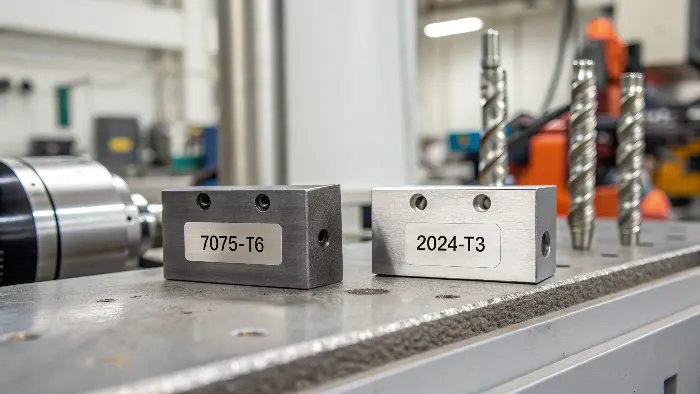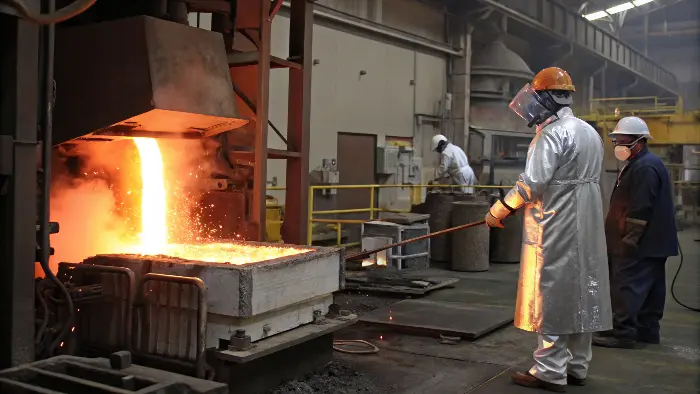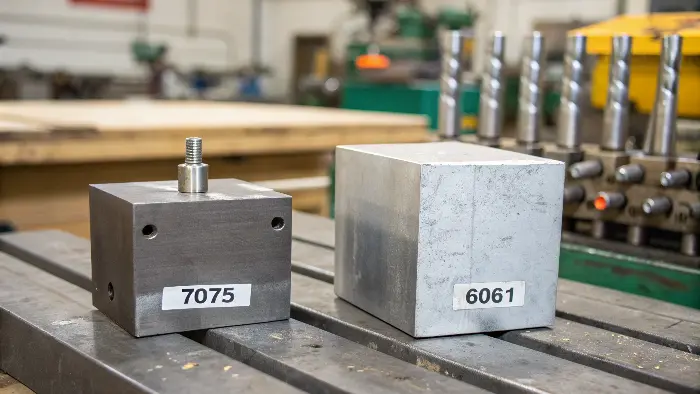Choosing the right aluminum alloy is tough. Pick wrong, and your parts fail. We make selection easy for strong, reliable components.
snippet paragraph:
Selecting the best aluminum alloy depends on its strength properties. Factors like tensile strength, yield strength, and hardness dictate an alloy’s suitability for specific manufacturing applications, from aerospace components to consumer electronics.
Understanding aluminum alloys can seem complex. There are so many types and designations. But don’t worry. I’m here to break it down for you, drawing on my years of experience in CNC machining. We’ll explore what makes each alloy unique. You need this information to make smart choices for your projects. Let’s dive into the specifics and find the perfect fit for your manufacturing needs.
How Do Common Aluminum Alloy Series Differ in Their Core Strength Characteristics?
Confused by aluminum series numbers like 6061 or 7075? This confusion can lead to over-engineering or weak parts. I’ll clarify their key strength differences.
Common aluminum alloy series (1xxx to 7xxx) vary greatly in strength. This is due to their primary alloying elements. For example, 7xxx series (Zinc) are very strong, while 1xxx series (Pure Aluminum) are softer.
When I first started in a CNC shop, understanding the vast array of aluminum alloys felt like learning a new language. But it’s crucial. Each series has a distinct personality, especially concerning strength. Let’s look at some common ones we machine daily at QuickCNCs.
1xxx Series (Pure Aluminum)
The 1xxx series is essentially pure aluminum, at least 99.0% pure. These alloys are not known for high strength. Instead, they offer excellent corrosion resistance, high thermal and electrical conductivity, and great workability. Their strength is low, so they are not typically used for structural applications. Think of electrical busbars or reflective surfaces.
2xxx Series (Copper)
Adding copper as the main alloying element, as in the 2xxx series, significantly increases strength. These alloys can achieve strength comparable to some steels, especially after heat treatment. A classic example is 2024 alloy. The downside is that they generally have lower corrosion resistance than many other aluminum alloys. We often see these in aerospace structures where strength-to-weight ratio is critical.
5xxx Series (Magnesium)
The 5xxx series alloys use magnesium as their principal alloying element. They offer good moderate-to-high strength, excellent corrosion resistance (especially in marine environments), and good weldability. 5052 is a very popular choice. It’s stronger than the 3xxx series but not as strong as 2xxx or 7xxx series. These are great for boat hulls, tanks, and pressure vessels.
6xxx Series (Magnesium and Silicon)
This is perhaps the most versatile and widely used group, with 6061 being the star. These alloys contain magnesium and silicon. They have good formability, weldability, machinability, and corrosion resistance, with medium strength. They are also heat-treatable to achieve even better strength. I’ve machined countless parts from 6061 for everything from bicycle frames to electronic enclosures.
7xxx Series (Zinc)
| For the highest strength aluminum alloys, you look to the 7xxx series, where zinc is the primary alloying element (often with magnesium or copper). Alloys like 7075 are workhorses in aerospace and high-stress structural applications. They offer exceptional strength-to-weight ratios, but can be more challenging to weld and may have lower corrosion resistance if not properly treated or protected. Here’s a simple table to summarize: |
Alloy Series | Main Alloying Element(s) | General Strength | Typical CNC Applications |
|---|---|---|---|---|
| 1xxx | (Pure Aluminum) | Low | Electrical components, chemical equipment | |
| 2xxx | Copper | High | Aerospace structures, high-strength fittings | |
| 5xxx | Magnesium | Moderate | Marine parts, tanks, welded structures | |
| 6xxx | Magnesium & Silicon | Medium to High | General purpose, structural, machine parts | |
| 7xxx | Zinc | Very High | Aerospace, high-stress parts, sporting goods |
Understanding these basic differences is the first step for engineers like Alex when specifying materials.
Which Aluminum Alloys Excel in High-Stress CNC Machining Applications?
Need parts that withstand extreme forces without failing? Choosing an under-strength alloy for high-stress jobs is a recipe for disaster. Let’s pinpoint the strongest options.
For high-stress CNC machining, alloys like 7075-T6 and 2024-T3 are top choices. Their excellent tensile and yield strengths make them ideal for aerospace, automotive, and structural components demanding high performance.

When a client like Alex comes to us at QuickCNCs needing parts for robotic arms or critical structural components, strength is usually the top priority. Not all aluminum alloys are created equal in this regard. Some are specifically designed for demanding, high-stress environments.
Identifying High-Stress Alloys
The "high-stress" champions are typically found in the 2xxx and 7xxx series. These alloys are heat-treatable, meaning their mechanical properties, especially strength, can be significantly enhanced.
Key Strength Metrics to Consider
When we talk about strength, engineers usually look at a few key numbers:
- Tensile Strength (Ultimate Tensile Strength – UTS): This is the maximum stress a material can withstand while being stretched or pulled before necking, which is when the specimen’s cross-section starts to significantly contract.
- Yield Strength: This is the stress at which a material begins to deform plastically. Before reaching the yield point, the material will deform elastically and will return to its original shape when the applied stress is removed. For structural parts, this is often more critical than tensile strength because once a part yields, it’s permanently deformed.
- Hardness: While not a direct measure of tensile or yield strength for design calculations, hardness (like Brinell or Rockwell) often correlates with strength and indicates resistance to indentation and wear.
Examples of High-Strength Aluminum Alloys
- 7075 Aluminum: This is one of the strongest aluminum alloys available. In its T6 temper (7075-T6), it boasts a tensile strength comparable to many mild steels, often exceeding 500 MPa (70-80 ksi). Its excellent strength-to-weight ratio makes it a favorite for aircraft structures, high-performance bicycle components, and military applications. I remember machining a complex fixture from 7075-T6 for a defense contractor; the material was tough, but the final part was incredibly robust.
-
2024 Aluminum: Another popular high-strength choice, especially in aerospace. In the T3 or T4 temper, 2024 offers very good strength and fatigue resistance. Its tensile strength can be in the range of 400-470 MPa (60-68 ksi). It’s often used for aircraft fuselage and wing structures where cyclic loading is a concern.
Here’s a comparison:Alloy Temper Typical Tensile Strength (MPa) Typical Yield Strength (MPa) Common High-Stress Applications 7075 T6 510 – 570 430 – 500 Aircraft frames, missile parts, high-stress structural parts 2024 T3/T4 400 – 470 270 – 330 Aircraft skins, fuselage, wing tension members 6061 T6 290 – 310 240 – 270 General structural, but lower than 7075/2024 for extreme stress While these alloys are strong, they can have trade-offs. For instance, 7075 typically has lower weldability and corrosion resistance compared to 6061. So, the "best" choice always depends on the full spectrum of application requirements, not just raw strength.
Can Heat Treatment Significantly Boost an Aluminum Alloy’s Strength for Manufacturing?
Think your chosen aluminum alloy isn’t strong enough? The base material might just need a little help. Heat treatment can transform its properties dramatically.
Yes, heat treatment can vastly increase aluminum alloy strength. Processes like solution heat treating and aging (precipitation hardening) alter the microstructure, significantly boosting tensile and yield strengths, particularly for 2xxx, 6xxx, and 7xxx series alloys.

I’ve seen many engineers surprised by how much an alloy’s properties can change with heat treatment. It’s like taking a good material and making it great for specific strength needs. At QuickCNCs, we frequently work with heat-treated alloys because our clients, especially those in demanding fields like Alex, need that extra performance.What is Heat Treatment for Aluminum?
For certain aluminum alloys (primarily the 2xxx, 6xxx, and 7xxx series, and some 8xxx series), heat treatment is a process involving controlled heating and cooling to alter their metallurgical structure. This change in structure directly impacts mechanical properties like strength and hardness. The most common type for strengthening is called precipitation hardening or age hardening.
The "T" Temper Designations
You’ll often see aluminum alloys specified with a "-T" followed by a number, like 6061-T6 or 7075-T651. This "T" indicates that the alloy has been thermally treated to produce stable tempers. Here are a few common ones:
- T1: Cooled from an elevated temperature shaping process and naturally aged.
- T3: Solution heat treated, cold worked, and naturally aged.
- T4: Solution heat treated and naturally aged.
- T5: Cooled from an elevated temperature shaping process and then artificially aged.
- T6: Solution heat treated and then artificially aged. This is a very common and popular temper for achieving high strength.
- T7: Solution heat treated and then stabilized (overaged) to improve stress corrosion cracking resistance, sometimes with a slight reduction in peak strength.
Impact on Microstructure and Strength
How does it work? In simple terms, solution heat treatment involves heating the alloy to a high temperature to dissolve the alloying elements into a solid solution. Then, it’s rapidly quenched (cooled) to "freeze" this solution. After quenching, the material is either naturally aged at room temperature or artificially aged by reheating to a lower temperature for a specific time. During aging, the dissolved alloying elements precipitate out as fine, uniformly dispersed particles within the aluminum matrix. These tiny particles act as obstacles to dislocation movement (which is how metals deform), thereby significantly increasing the material’s strength and hardness.
For example, 6061 in its annealed state (6061-O) might have a tensile strength around 125 MPa. After heat treating to the T6 temper (6061-T6), its tensile strength can jump to over 310 MPa – more than double!Alloy Temper Process Effect on Strength Typical Yield Strength of 6061 (MPa) O (Annealed) Annealed to achieve lowest strength, highest ductility Lowest Strength ~55 T4 Solution heat-treated and naturally aged Good Strength, good ductility ~145 T6 Solution heat-treated and artificially aged High Strength ~276 Understanding and specifying the correct temper is just as important as choosing the alloy itself. It’s a critical detail for ensuring the final CNC machined part meets the performance requirements for demanding applications.
How Does an Alloy’s Strength Affect Its Machinability and Overall Project Cost?
Opting for the strongest aluminum seems logical, right? But this choice can sometimes inflate machining time and costs unexpectedly. Let’s explore this balance.
Stronger aluminum alloys, like 7075, are generally harder and more abrasive. This often leads to slower machining speeds, increased tool wear, and thus higher machining costs compared to softer, more machinable alloys like 6061.

In my experience managing CNC projects at QuickCNCs, a common discussion with clients revolves around material choice and its impact on cost. While a super-strong alloy might seem ideal on paper for Alex’s robotic components, we also need to consider how it behaves on the machine. There’s a definite link between an alloy’s strength, its machinability, and the final price tag.The Machinability Index
Machinability isn’t a single, precise property but rather a general term describing how easily a material can be cut. Factors include tool life, cutting speeds, surface finish achieved, and chip formation. Some alloys are "gummy," leading to built-up edges on tools, while others are abrasive, wearing tools down quickly. Generally, very soft alloys can be gummy, and very hard, strong alloys can be abrasive and tough to cut. There are machinability ratings, often relative to a standard material.
Stronger Isn’t Always Easier (or Cheaper)
Generally, as the strength and hardness of an aluminum alloy increase, its machinability tends to decrease.
- Softer Alloys (e.g., 6061-T6): This is often considered one of the most machinable aluminum alloys. It produces good chips, allows for relatively high cutting speeds, and results in good tool life. This translates to faster cycle times and lower per-part machining costs.
- Harder, Stronger Alloys (e.g., 7075-T6, 2024-T3): These alloys are significantly tougher. Machining them often requires slower cutting speeds, more robust tooling (sometimes specialized coatings), and more careful process control to manage heat and tool wear. This means longer machining times and potentially more frequent tool changes. All these factors add to the cost. I’ve seen jobs where switching from 6061 to 7075, while necessary for strength, increased machining time by 20-30%.
Cost Implications
The raw material cost is one factor, but machining cost is often a larger component.
- Material Cost: High-strength alloys like 7075 are typically more expensive per kilogram than common alloys like 6061.
- Machining Time: Longer cycle times directly increase labor and machine operational costs.
- Tooling Cost: Increased tool wear means more money spent on cutting tools.
-
Complexity: For very hard materials, achieving tight tolerances or fine surface finishes can be more challenging, potentially requiring extra steps or more skilled handling.
Here’s a general idea:Alloy Group General Strength Relative Hardness Typical Machinability Rating Relative Machining Cost 1xxx, 3xxx Series Low Low Fair to Good (can be gummy) Low to Medium 6061-T6 Medium Medium Excellent Low 2024-T3/T4 High Medium-High Fair to Good Medium 5xxx Series Moderate Medium Good Medium 7075-T6 Very High High Fair Medium to High It’s always a balancing act. We need to select an alloy that meets the strength requirements without unnecessarily driving up manufacturing costs. Sometimes, a slightly less strong but much more machinable alloy, perhaps with a design tweak, can be a more economical overall solution. This is where early consultation with a manufacturing partner like QuickCNCs really pays off.
Conclusion
Choosing the right aluminum alloy involves balancing strength, machinability, and cost. Understanding these properties ensures optimal performance and value for your CNC machined parts.


